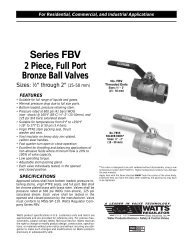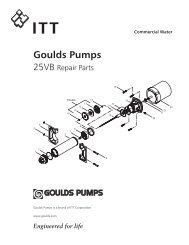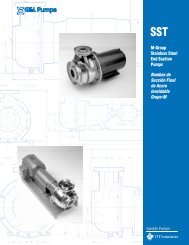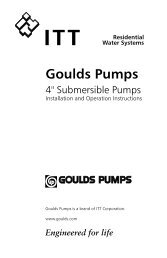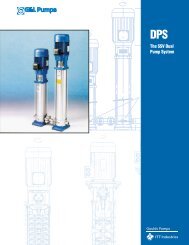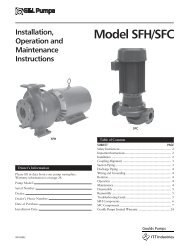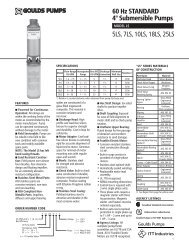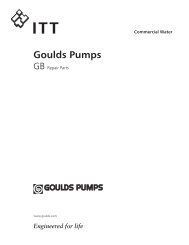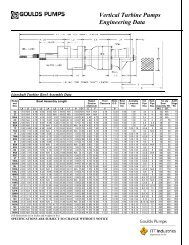4" Submersible Pumps
4" Submersible Pumps
4" Submersible Pumps
You also want an ePaper? Increase the reach of your titles
YUMPU automatically turns print PDFs into web optimized ePapers that Google loves.
2.0 PIPING<br />
Notice: All 4" Goulds <strong>Pumps</strong><br />
submersibles have left-hand<br />
discharge head threads, hold the<br />
pump only at the “discharge head”<br />
with a wrench when installing<br />
fittings or threaded pipe.<br />
CAUTION<br />
Hazardous pressure can<br />
cause personal injury or<br />
property damage.<br />
2.1 General<br />
The pump discharge<br />
piping should be sized<br />
for efficient pump<br />
operation. We suggest<br />
using the Friction Loss<br />
Tables to calculate Total Dynamic<br />
Head using different pipe sizes. As<br />
a rule of thumb use 1" for up to<br />
10 gpm, 1 1 ⁄4" for up to 30 gpm, 1 1 ⁄2"<br />
for up to 45 gpm, and 2" for up to<br />
80 gpm. In the case of long pipe<br />
runs it is best to increase pipe size.<br />
Some pumps are capable of very<br />
high discharge pressures, please<br />
select pipe accordingly. Since<br />
Goulds <strong>Pumps</strong> does not sell pipe,<br />
we suggest you consult with your<br />
pipe supplier to determine the best<br />
type of pipe for each installation.<br />
CAUTION<br />
Hazardous pressure can<br />
cause personal injury or<br />
property damage.<br />
2.2Pressure Tank,<br />
Pressure Switch<br />
and Pressure<br />
Relief Valve<br />
Select an area in which<br />
the ambient temperature<br />
is always above 34° F (1° C) in<br />
which to install the tank, pressure<br />
switch, and pressure relief valve.<br />
The tank should be located in an<br />
area where a leak will not damage<br />
property.<br />
The pressure switch should be<br />
located at the tank cross tee and<br />
never more than 4' from the tank.<br />
Locating the switch more than<br />
4' from the tank will cause<br />
switch chatter.<br />
There should be no valves, filters,<br />
or high loss fittings between the<br />
switch and the tank(s) as switch<br />
chatter may result. As an example,<br />
a 1 1 ⁄4" spring check valve has<br />
friction loss equal to 12' of pipe,<br />
placing the valve between the<br />
pressure switch and the pressure<br />
tank is the same as moving the<br />
pressure switch 12' away from the<br />
tank. It will create switch chatter.<br />
On multiple tank installations the<br />
switch should be as close to the<br />
center of the tanks as possible.<br />
Multiple tank installations should<br />
have a manifold pipe at least 1 1 ⁄2<br />
times the size of the supply pipe<br />
from the pump. This is to reduce<br />
the Friction Head in the manifold<br />
and to reduce the possibility of<br />
switch chatter.<br />
The cut-in setting on a 30 - 50<br />
pressure switch is 30 psi. Cut-in is<br />
the lower of the pressure settings.<br />
Pressure relief valves are required<br />
on any system that is capable of<br />
producing 100 psi or 230' TDH. If<br />
in an area where a water leak or<br />
blow-off may damage property<br />
connect a drain line to the pressure<br />
relief valve. Run it to a suitable<br />
drain or an area where the water<br />
will not damage property.<br />
2.3 Adjusting Tank<br />
Pre-Charge<br />
Insure that the tank is empty of<br />
water. Use a high quality pressure<br />
gauge to check the tank pre-charge<br />
pressure. The pressure should be<br />
2 psi below the pump cut-in<br />
pressure. As an example, a<br />
30-50 psi system would use<br />
a tank pre-charge of 28 psi.<br />
5



